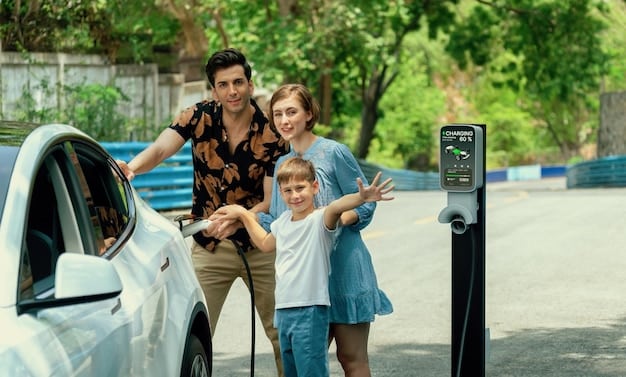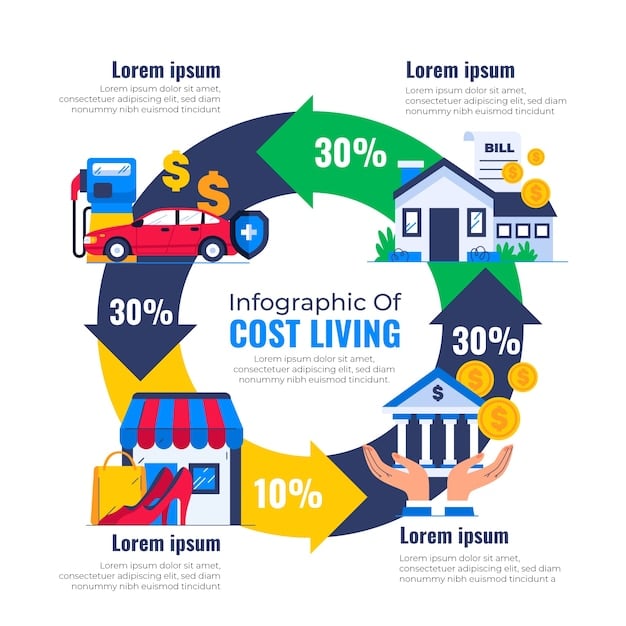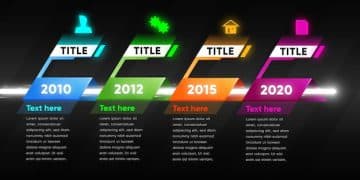2025 EV Tax Credits: Save Up to $7,500 on Electric Vehicles

The updated 2025 federal tax credits significantly enhance the affordability of electric vehicles (EVs) in the US, offering eligible buyers up to a $7,500 incentive directly at the point of sale, contingent upon meeting specific criteria for vehicle origin and battery components.
As the nation accelerates its transition to sustainable transportation, understanding how the updated 2025 federal tax credits can save you up to $7,500 on an electric vehicle is crucial for prospective buyers. These incentives are not just a perk; they represent a significant financial boost designed to make eco-friendly driving more accessible and appealing to a broader audience across the United States. Delving into the nuances of these revised credits can illuminate a clear path towards substantial savings on your next EV purchase.
Understanding the Evolution of EV Tax Credits
The landscape of federal tax credits for electric vehicles has undergone significant transformations, particularly with the updates slated for 2025. These changes are not arbitrary; they reflect a concerted effort by the government to stimulate domestic manufacturing, strengthen supply chains, and ultimately make EVs more affordable for American families. Before diving into the specifics of the 2025 incentives, it’s beneficial to grasp the historical context that led to these pivotal adjustments..
Initially, EV tax credits were largely designed as a blanket incentive to spur early adoption. However, as the market matured and geopolitical considerations came to the forefront, policymakers began to refine these incentives. The goal shifted from simply encouraging EV purchases to fostering a robust, localized EV ecosystem that benefits American workers and reduces reliance on foreign production. This evolution culminated in the Inflation Reduction Act (IRA), which laid the groundwork for the 2025 updates, emphasizing vehicle assembly and battery component sourcing within North America.
Key Shifts in Eligibility Criteria
The most notable changes for 2025 revolve around stricter eligibility requirements, particularly concerning vehicle manufacturing and battery content. Buyers need to pay close attention to these details, as a seemingly identical model might qualify one year but not the next, or vice versa, based on where its components originate. This emphasis on domestic sourcing is a double-edged sword: it aims to bolster the US economy but can also limit the number of qualifying models in the short term.
- North American Assembly: Vehicles must be assembled in North America to qualify. This critical requirement aims to bring more automotive manufacturing jobs to the US, Canada, and Mexico.
- Battery Component Sourcing: A significant percentage of the battery components must be manufactured or assembled in North America. This particular stipulation is designed to decrease dependence on foreign supply chains and encourage local production.
- Critical Mineral Requirement: A specified percentage of the battery’s critical minerals must be extracted or processed in the US, or in a country with a free-trade agreement with the US, or recycled in North America. This aims to secure the supply of vital materials.
These stringent requirements mean that not all electric vehicles will be eligible for the full $7,500 credit. Consumers will need to consult official government resources or manufacturer disclosures to confirm if a specific model meets the criteria. This level of detail underscores the government’s commitment to building a self-sufficient EV industry capable of scaling production and innovation domestically.
How the $7,500 Credit Works in 2025
The updated 2025 federal tax credits introduce a fundamentally new approach to how potential savings are realized at the point of sale. This shift from a post-purchase tax credit to an immediate discount is a game-changer, designed to make electric vehicles significantly more appealing and affordable upfront. No longer will buyers have to wait until tax season to claim their incentive; the savings can now be applied directly when they drive off the lot.
This immediate gratification helps to alleviate the common barrier of initial cost, which has historically deterred many potential EV adopters. It transforms the $7,500 credit from a future reimbursement into a tangible reduction in the purchase price, making a real difference in monthly payments and overall affordability. This mechanism reflects a deeper understanding of consumer behavior and financial planning, removing a layer of complexity and uncertainty.
Point-of-Sale Transfer Program
One of the most significant changes for 2025 is the implementation of the Point-of-Sale Transfer Program. This program allows eligible buyers to transfer their tax credit directly to the dealership at the time of purchase. The dealership then applies this amount as an immediate discount on the vehicle’s price. This streamlines the process and ensures that buyers benefit from the incentive without the need to calculate or wait for their tax refund.
For the dealership, participation in this program involves a few steps to ensure compliance and proper submission of documentation to the IRS. Once approved, the dealership is reimbursed for the credit amount, making it a seamless transaction for both parties. This mechanism eliminates the need for the buyer to have a sufficient tax liability to claim the credit, expanding its accessibility to a wider range of income earners.
This immediate discount can be particularly impactful for those who might not have had a large enough tax liability to fully utilize the credit under the previous system. It democratizes access to EV incentives, allowing more individuals to partake in the economic benefits of switching to an electric vehicle. The direct application of the credit at the time of purchase also simplifies budgeting and financial planning, providing a clear upfront cost for the consumer.
Income and Vehicle Price Limitations
Beyond the manufacturing and battery requirements, the 2025 credits also come with specific income and vehicle price limitations designed to target the incentives more effectively. These income caps ensure that the credit primarily benefits middle-to-lower-income households, preventing wealthier buyers from disproportionately benefiting from public funds.
- Adjusted Gross Income (AGI) Caps:
- Single filers: AGI cannot exceed $150,000.
- Head of household filers: AGI cannot exceed $225,000.
- Married couples filing jointly: AGI cannot exceed $300,000.
- Manufacturer’s Suggested Retail Price (MSRP) Caps:
- Vans, SUVs, and pickup trucks: MSRP cannot exceed $80,000.
- Other vehicles (sedans, coupes): MSRP cannot exceed $55,000.

These price caps are critical for keeping the incentives focused on a broader range of vehicles, rather than exclusively supporting luxury models. They encourage manufacturers to produce more affordable EVs that meet the needs of the average American consumer. Both the income and vehicle price limitations are self-reported by the consumer, but subject to verification by the IRS, so accurate reporting is essential.
Qualifying Vehicles: What to Look For in 2025
The landscape of qualifying electric vehicles for the 2025 federal tax credits is highly dynamic, a direct consequence of the updated regulations focusing on domestic manufacturing and supply chain resilience. This means that merely being an EV is no longer sufficient; the vehicle needs to meet rigorous standards related to its origin and the components that power it. Navigating these requirements can be complex, but understanding the core principles is key to identifying eligible models.
Automakers are continually adjusting their production strategies and supply chains to meet these new criteria, so the list of eligible vehicles can change. Prospective buyers should be proactive in their research, consulting official government lists and manufacturer websites, which are typically updated regularly. The emphasis is on transparency and providing consumers with the most current information available to make informed purchasing decisions.
Domestic Assembly and Battery Sourcing Requirements
At the heart of the 2025 eligibility are the requirements for North American final assembly and the sourcing of battery components. These stipulations are designed to bolster the domestic economy and reduce dependencies on foreign supply chains. For a vehicle to qualify, its final assembly must take place in North America, which includes the United States, Canada, and Mexico. This is a clear indicator of the government’s push to onshore manufacturing jobs.
Equally important is the origin of the battery components. The credit is split into two halves: $3,750 for meeting critical mineral requirements and $3,750 for battery component requirements. Both halves depend on a percentage of the value of these components being sourced or processed in North America or from free trade agreement countries. This ensures that the benefits of the credit extend further down the supply chain, supporting mining, processing, and manufacturing operations within the region.
Manufacturers are transparently disclosing which models meet these criteria, often directly on their official websites or through official press releases. Buyers should always cross-reference this information with the official government sources, such as the Department of Energy’s FuelEconomy.gov website, which provides an updated list of qualifying vehicles. This due diligence ensures that the chosen EV model indeed qualifies for the anticipated credit.
Impact on Different EV Segments
The updated criteria are likely to have varying impacts across different segments of the electric vehicle market. Sedans, SUVs, vans, and pickup trucks will all be subject to the same strict manufacturing and battery sourcing rules, but their individual price caps can influence which models remain competitive for the credit.
- Popular Sedans: Many popular electric sedans, particularly those produced by established foreign manufacturers, may struggle to meet the North American assembly or critical mineral requirements if their supply chains are globally distributed.
- SUVs and Trucks: Larger vehicles, like electric SUVs and pickup trucks, typically have higher MSRPs. While they benefit from an $80,000 price cap, their battery complexity and higher material requirements mean their manufacturers face significant challenges in meeting the domestic content thresholds.
- Luxury EVs: High-end luxury EVs will likely be excluded due to both their MSRP exceeding the caps and, in many cases, their reliance on global supply chains that do not yet align with the North American-centric requirements.
This nuanced impact means that some vehicles that were previously eligible might no longer be, while others may become newly eligible as manufacturers adapt their production lines. This dynamic environment places a premium on staying informed and consulting the latest eligibility lists. The updated mandates effectively shape the future of the EV market, promoting specific manufacturing practices and supply chain strategies over others.
Navigating the Purchase Process with the New Credits
The updated 2025 federal tax credits significantly streamline the process of receiving your EV incentive, moving from a future tax credit to an immediate discount. This change fundamentally alters how prospective buyers should approach their purchase, requiring a new understanding of interactions with dealerships and the documentation involved. The goal is to make the process as straightforward as possible, ensuring that the savings are both tangible and accessible at the moment of sale.
No longer will you need to wait for tax season to claim your $7,500; the savings are applied directly to the purchase price of your electric vehicle. This immediate benefit can greatly simplify financial planning and make the decision to go electric much more appealing. However, it’s still crucial to be well-informed and prepared to ensure a smooth transaction.
Steps for Claiming Your Instant Discount
Claiming your instant discount through the 2025 federal tax credits involves a few key steps to ensure eligibility and proper processing. The most significant change is the ability to transfer the credit directly to the dealership, who then reduces the purchase price of the vehicle by up to $7,500. This is a crucial distinction from previous years where the credit was claimed on your tax return.
Before heading to the dealership, it’s essential for buyers to confirm their income eligibility and ensure the chosen vehicle meets all the necessary criteria, including North American assembly and battery component sourcing. Although the dealership will confirm eligibility for the vehicle, the buyer remains responsible for meeting the income requirements. Transparency and accuracy in providing personal information are paramount.
Upon selecting an eligible EV, the dealership will facilitate the transfer of the tax credit. This involves filling out a form provided by the IRS, which certifies that the buyer meets the income requirements and agrees to transfer the credit to the dealer. The dealer then submits this documentation to the IRS and applies the discount to the final purchase price. This simplified process aims to remove the financial barrier of waiting for a tax refund, making EV ownership more accessible.
Dealership Responsibilities and Buyer Verification
Under the new system, dealerships play a more active role in the administration of the federal tax credits. They are responsible for verifying that the vehicles they sell meet the qualification criteria for North American assembly and battery component sourcing. This includes keeping up-to-date with the latest IRS guidelines and manufacturer certifications. Reputable dealerships will have clear information available about which of their EV models qualify for the credit.
While dealerships verify vehicle eligibility, buyers still bear the responsibility of confirming their own income eligibility. The income caps set for single filers, head of household, and married couples filing jointly are critical for determining whether a buyer can receive the credit. Dealers may ask for an attestation or certification from the buyer regarding their income status to facilitate the point-of-sale transfer.
It’s important for buyers to understand that if, after purchase, it is determined they did not meet the income criteria, they may be subject to repaying the credit amount to the IRS. Therefore, accurate self-assessment of income eligibility is paramount. Having a clear understanding of your Adjusted Gross Income (AGI) from previous tax years can provide a good estimate. This shared responsibility ensures the integrity of the program while streamlining the benefit for consumers.

Beyond the Federal Credit: State and Local Incentives
While the federal tax credit of up to $7,500 is a significant incentive, it’s important for prospective electric vehicle buyers to remember that it’s often just one piece of a larger financial puzzle. Many states, local governments, and even utility companies offer additional incentives that can further reduce the cost of purchasing or leasing an EV. These supplementary programs can cumulatively add up to substantial savings, making the transition to an electric vehicle even more appealing.
Researching these localized incentives is a critical step in maximizing your overall savings. Each state and local entity has its own set of rules, eligibility requirements, and application processes, so a comprehensive understanding of what’s available in your specific area is essential. These incentives often reflect regional priorities, such as air quality improvements, economic development, or renewable energy goals, thereby creating a diverse ecosystem of support for EV adoption.
Exploring State-Specific Programs
State-specific EV incentive programs vary widely, ranging from additional tax credits and rebates to unique benefits like HOV lane access for single drivers. For instance, some states offer rebates that can be applied directly at the point of sale, similar to the new federal program, while others provide tax credits that are claimed on state income tax returns. It’s not uncommon for states with strong environmental initiatives to have more robust incentive packages.
Beyond direct financial incentives, many states also offer non-monetary perks that can add significant value. These might include reduced vehicle registration fees, exemptions from emissions testing, or even public charging infrastructure installation support. These benefits often complement the financial savings by reducing the ongoing costs of EV ownership. Keeping abreast of these varied state-level offerings requires dedicated research, typically through official state government websites or dedicated clean energy portals.
A good starting point for your research is often your state’s Department of Energy or Environmental Protection Agency website. They frequently host comprehensive lists of available incentives and provide links to relevant programs. Additionally, many EV advocacy groups and environmental organizations maintain updated databases of state and local incentives, offering a consolidated resource for potential buyers. These resources are invaluable for piecing together the full spectrum of available savings.
Local and Utility Company Rebates
The incentives for EV adoption don’t stop at the state level; many local governments and even public utility companies offer their own programs. These can include rebates for the purchase of a new or used EV, subsidies for installing home charging equipment (Level 2 chargers), or special rates on electricity during off-peak hours for EV charging. These localized incentives are particularly significant because they often address the practical aspects of EV ownership, such as charging infrastructure.
For example, some municipalities offer grants for residents to install charging stations in their homes, while others might provide discounted permits for public charging. Utility companies, keen to manage grid demand and promote renewable energy, frequently offer significant rebates for smart chargers or provide favorable electricity rates for EV owners who charge their vehicles overnight. These seemingly smaller incentives can collectively add up, especially when considering the long-term operational costs of an EV.
To discover these hyper-local incentives, it’s advisable to check your city or county government’s official website, particularly under departments related to sustainability or transportation. Contacting your local utility provider directly is also a productive step, as they often have specific programs designed for their customers who own electric vehicles. Combining federal, state, and local incentives can dramatically reduce the financial outlay required for an EV, making it an even more cost-effective choice.
Future Outlook: What to Expect Post-2025
The updated 2025 federal tax credits significantly reshape the electric vehicle market, but the evolution of these incentives is an ongoing process. As the EV industry continues to mature, and as national energy and environmental policies adapt, further adjustments to tax credits and other support mechanisms are highly probable. Understanding these potential future shifts is important for both consumers considering an EV purchase and for manufacturers planning their long-term strategies.
The emphasis on domestic manufacturing and strong supply chains is unlikely to wane, given the current geopolitical and economic climate. This suggests that future incentives will continue to prioritize vehicles and components sourced from North America, or from countries with strong trade agreements. Such a consistent policy direction provides a degree of predictability for the industry, even as specific credit amounts or eligibility criteria may evolve.
Potential Adjustments and Program Longevity
While the 2025 framework introduces significant stability, it is reasonable to expect potential adjustments in the years that follow. The tax credit program’s longevity itself is a topic of discussion. Historically, government incentives of this nature are not indefinite; they often sunset or are modified once the market reaches a certain level of self-sufficiency. However, the current robust push for EV adoption suggests that some form of incentive will likely remain in place for the foreseeable future.
Potential adjustments could include changes to the critical mineral and battery component percentage requirements, which are subject to gradual increases over time, making eligibility even stricter. There might also be shifts in the income and MSRP caps, either to broaden accessibility or to refine the targeting of incentives based on market dynamics. The overall goal will remain to strike a balance between encouraging EV adoption and ensuring fiscal responsibility.
Policymakers continuously evaluate the effectiveness of these programs, and future modifications will undoubtedly be informed by data on EV sales, domestic manufacturing growth, and environmental impacts. Stakeholders, including consumer advocacy groups, environmental organizations, and industry associations, will also play a role in shaping the future landscape of EV incentives. Staying informed through official government announcements and credible news sources will be key to understanding these evolving dynamics.
Long-Term Vision for Electric Mobility
The federal tax credits are part of a much broader, long-term vision for electric mobility in the United States. This vision encompasses not just the vehicles themselves, but also the entire ecosystem supporting them, including charging infrastructure, grid modernization, and domestic battery recycling capabilities. The incentives for EV purchases are designed to accelerate this transition, but they are complemented by other federal investments in infrastructure and technology research.
In the coming years, we can anticipate continued investment in public charging networks, particularly in underserved areas, to alleviate range anxiety and make EV travel more convenient. There will also likely be an increased focus on the sustainable sourcing and recycling of battery materials, ensuring that the environmental benefits of EVs extend across their entire lifecycle. These complementary initiatives will work in tandem with purchase incentives to create a robust and sustainable electric transportation system.
Ultimately, the goal is to reach a point where electric vehicles are the default choice for consumers, not just because of incentives, but because they are superior in performance, cost-effective to own, and seamlessly integrated into daily life. The 2025 tax credits play a pivotal role in accelerating this transition, moving the nation closer to a future powered by clean, reliable electric energy. This comprehensive approach underscores the government’s commitment to a greener, more sustainable future for transportation.
Beyond the Purchase: Total Cost of EV Ownership
While the up to $7,500 federal tax credit significantly reduces the upfront cost of an electric vehicle, the financial benefits of owning an EV extend far beyond the initial purchase. Understanding the total cost of ownership (TCO) is crucial for a complete financial picture, revealing how an EV can lead to substantial long-term savings compared to a conventional gasoline-powered vehicle. The TCO includes not just the purchase price, but also ongoing expenses like fuel, maintenance, insurance, and even potential resale value.
Many prospective buyers focus solely on the sticker price, overlooking the substantial operational savings that EVs offer. These long-term financial advantages are a core part of the value proposition for electric vehicles and are often the deciding factor for those looking to maximize their savings over the lifespan of their car. A detailed analysis of TCO can highlight these often-underestimated benefits.
Fuel Savings and Charging Efficiency
One of the most immediate and significant savings for EV owners comes from fuel costs. Electricity is generally much cheaper per mile than gasoline, especially when charging at home during off-peak hours. The exact savings will vary based on local electricity rates and gasoline prices, but the trend consistently shows that “fueling up” an EV is considerably more economical.
Furthermore, the efficiency of EVs in converting energy to motion is superior to internal combustion engines. While gasoline engines waste a significant amount of energy as heat, electric motors are highly efficient, translating more of the stored energy into wheel power. This efficiency means that for every dollar spent on electricity, an EV travels further than a gasoline car would with a dollar’s worth of fuel.
Many utility companies offer special time-of-use tariffs for EV charging, providing even lower rates during specific periods, typically overnight. Utilizing these programs, combined with smart charging solutions, can dramatically reduce monthly energy bills. The cost stability of electricity compared to the volatile prices of gasoline also provides a greater sense of predictability for monthly transportation expenses, adding another layer of financial peace of mind for EV owners.
Maintenance and Insurance Implications
Another area where EVs typically offer savings is in maintenance. Electric vehicles have fewer moving parts than gasoline cars, meaning there are fewer components to break down or require regular servicing. There’s no engine oil to change, no spark plugs to replace, no timing belts, and no complex exhaust systems to maintain. This simplification of mechanics translates into lower routine maintenance costs and fewer trips to the service center.
- Reduced Fluid Changes: EVs do not require engine oil, transmission fluid, or coolant changes in the same way gasoline cars do, leading to fewer scheduled maintenance appointments.
- Fewer Wear Items: Components like brake pads may last longer in EVs due to regenerative braking, which uses the electric motor to slow the vehicle and recharge the battery, reducing reliance on conventional friction brakes.
- Simplified Powertrain: The absence of a complex internal combustion engine and transmission system significantly reduces the number of potential failure points and associated repair costs.
Insurance costs for EVs can be
more complex. While some insurers might offer discounts for environmentally friendly vehicles, the higher initial purchase price and specialized repair expertise required for EVs can sometimes lead to slightly higher insurance premiums. However, as EV adoption grows and repair networks expand, these differences are likely to diminish. It’s always advisable to compare insurance quotes for specific EV models to get an accurate picture of potential costs.
Environmental Benefits and Societal Impact of EVs
The individual financial incentives and long-term cost savings associated with electric vehicles are compelling, but their broader environmental and societal benefits are arguably even more significant. Choosing an EV is not merely an economic decision; it is a step towards a more sustainable future, contributing positively to air quality, climate change mitigation, and energy independence. Understanding these wider impacts can add another layer of motivation for prospective buyers.
The transition to electric mobility represents a fundamental shift in how we power our transportation, moving away from fossil fuels and towards cleaner energy sources. This shift has ripple effects across various sectors, from public health to national security, making EV adoption a multifaceted benefit for society as a whole. The collective impact of individual choices in this domain is profound and far-reaching.
Reduced Emissions and Air Quality Improvement
One of the most immediate and tangible benefits of electric vehicles is the significant reduction in tailpipe emissions. EVs produce zero tailpipe emissions, meaning they do not release harmful pollutants like nitrogen oxides, particulate matter, and volatile organic compounds directly into the atmosphere during operation. These pollutants are known contributors to smog, acid rain, and a host of respiratory and cardiovascular diseases.
Even when considering the emissions associated with electricity generation, EVs generally result in a lower carbon footprint than gasoline cars, especially in regions with a high proportion of renewable energy sources in their grid mix. As national grids continue to decarbonize, the environmental benefits of EVs will only grow. This direct impact on air quality is particularly crucial in urban areas, where vehicle emissions are a major source of air pollution, thereby improving public health outcomes.
The collective shift to EVs can lead to substantial improvements in urban air quality, reducing instances of asthma, bronchitis, and other respiratory illnesses. This benefit extends beyond the immediate vicinity of vehicles, contributing to regional air quality enhancements. These reductions in air pollution represent immense public health savings and reinforce the role of EVs as a key component of sustainable urban planning.
Mitigating Climate Change and Energy Independence
Beyond local air quality, EVs play a critical role in mitigating climate change by reducing greenhouse gas emissions. Transportation is a major source of carbon dioxide, the primary greenhouse gas contributing to global warming. By relying on electricity, which can be generated from renewable sources, EVs offer a pathway to drastically cut transportation-related carbon emissions.
Furthermore, widespread EV adoption contributes to greater energy independence for the United States. By reducing reliance on imported fossil fuels, the nation strengthens its energy security and becomes less vulnerable to fluctuations in global oil markets. This shift diverts energy expenditure from foreign oil producers towards domestic electricity generation, supporting local economies and creating jobs within the clean energy sector.
The drive towards a fully electrified transportation system also stimulates innovation in battery technology, smart grid solutions, and renewable energy infrastructure. This technological advancement not only benefits the environment but also positions the U.S. as a leader in emerging industries, fostering economic growth and creating new opportunities. The long-term vision intertwines environmental stewardship with economic progress, making the transition to EVs a strategic imperative.
| Key Point | Brief Description |
|---|---|
| 🚗 Instant Savings | Up to $7,500 credit directly at point of sale, no more waiting for tax season. |
| 🗺️ North American Focus | Vehicles and battery components must meet strict domestic sourcing rules for eligibility. |
| 💰 Income/Price Caps | Eligibility subject to AGI limits ($150-300K) and MSRP caps ($55-80K) on vehicles. |
| 📈 Beyond Federal | Explore state, local, and utility incentives for additional savings and benefits. |
Frequently Asked Questions About 2025 EV Tax Credits
The primary change for 2025 is the shift from a post-purchase tax credit to an immediate discount of up to $7,500 at the point of sale. Additionally, eligibility criteria are stricter, requiring vehicles to be assembled in North America and their batteries to meet specific North American component and critical mineral sourcing requirements.
To verify if an EV model qualifies, you should consult the official government website (such as FuelEconomy.gov from the Department of Energy) and the manufacturer’s own disclosures. These sources are regularly updated with the latest information on eligible vehicles that meet assembly, battery component, and critical mineral requirements.
Yes, there are income limitations based on your Adjusted Gross Income (AGI). The caps are $150,000 for single filers, $225,000 for head of household, and $300,000 for married couples filing jointly. Exceeding these limits will disqualify you from receiving the instant discount.
Under the new point-of-sale transfer program, the credit is applied as an instant discount, meaning your tax liability is no longer a limiting factor. You can receive the full discount at the dealership, provided you meet all vehicle and income eligibility requirements, regardless of your personal tax liability.
Many states, local governments, and even utility companies offer additional incentives for EV purchases, leases, or home charging equipment installation. These can include state tax credits, rebates, HOV lane access, or special electricity rates. Researching these localized programs can significantly increase your overall savings.
Conclusion
The updated 2025 federal tax credits mark a significant turning point in making electric vehicles more accessible and affordable for Americans. By offering up to $7,500 as an immediate point-of-sale discount, these incentives remove a major financial barrier, allowing more consumers to embrace sustainable transportation without waiting for tax season. While the eligibility criteria are stricter, emphasizing North American manufacturing and supply chain resilience, these changes are designed to foster a robust domestic EV industry while simultaneously benefiting buyers. Navigating these requirements, alongside exploring state and local incentives, provides a clear pathway to substantial savings. The journey towards a greener, more cost-effective driving future is becoming increasingly tangible, driven by thoughtful policies that blend economic advantages with vital environmental stewardship.





